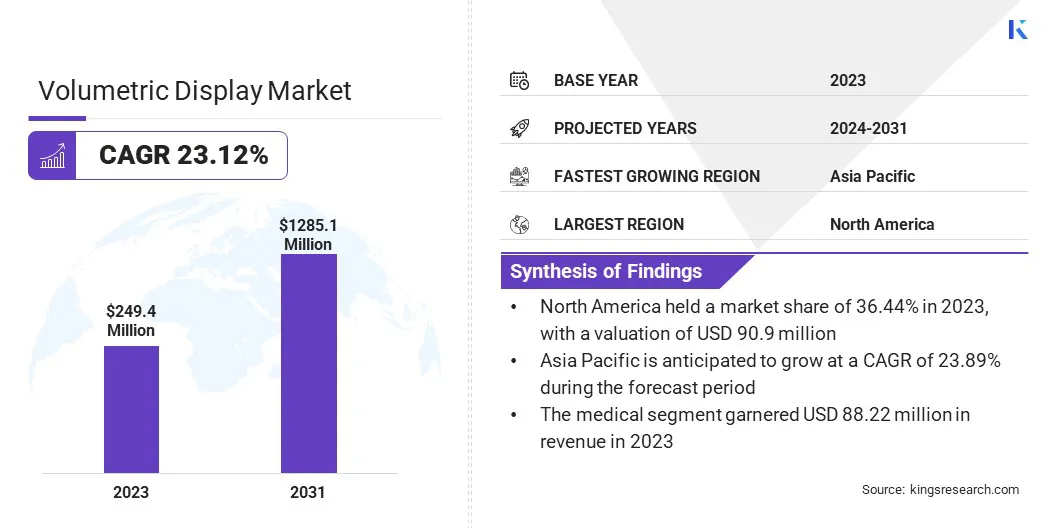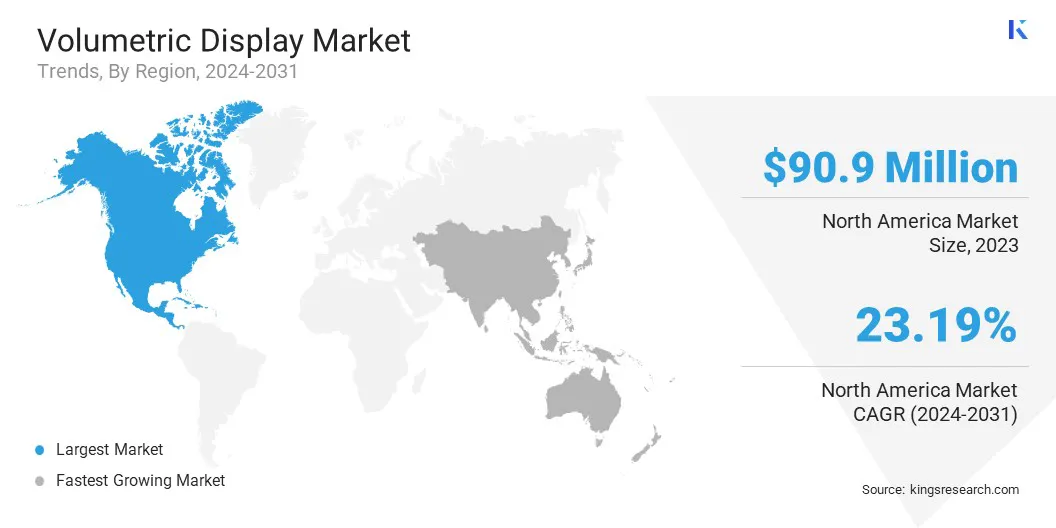Market Definition
A volumetric display is a 3D visualization technology that creates images visible from multiple angles without the need for glasses or other special viewing devices. It works by projecting light onto a medium, such as a rotating screen or a photonic crystal, which displays 3D images in a continuous volume, allowing for real-time interaction.
The advantages of volumetric displays include enhanced depth perception, immersive experiences, and the ability to visualize complex 3D data beyond the capabilities of traditional 2D screens.
Volumetric Display Market Overview
Global volumetric display market size was valued at USD 249.4 million in 2023 and is projected to grow from USD 299.6 million in 2024 to USD 1,285.1 million by 2031, exhibiting a CAGR of 23.12% during the forecast period.
The rising demand for advanced 3D visualization solutions in medical diagnostics and surgical planning is driving the adoption of volumetric displays in healthcare. Additionally, the growing focus on enhancing user experience in entertainment and virtual reality applications is fueling the growth of the market.
Major companies operating in the volumetric display market are Voxiebox Pty Ltd, Looking Glass, Leia Inc., Holoxica Ltd, HOLOGRAFIKA, SeeReal Technologies S.A., REALFICTION, Sony Corporation, Wammes & Partner GmbH, LIGHTSPACE LABS, Inc., SEEKWAY, LedPulse Technologies, Lazulite Technology Services LLC, Digital Light Advertising LLC, The Coretec Group., and others.
The entertainment industry is increasingly adopting volumetric display technology to enhance immersive experiences in gaming, augmented reality (AR), and virtual reality (VR).
Volumetric displays offer the potential to provide more realistic, interactive, and engaging experiences by displaying three-dimensional images or scenes that can be viewed from different angles without the need for special glasses or headsets.
In gaming, volumetric displaysenhances realism and interactivity by making virtual environments more tangible and dynamic. In AR and VR, these displays enable the creation of lifelike virtual objects or environments that seamlessly integrate with the real world, adding a new dimension to digital experiences.

Key Highlights:
- The volumetric display industry size was recorded at USD 249.4 million in 2023.
- The market is projected to grow at a CAGR of 23.12% from 2024 to 2031.
- North America held a share of 36.44% in 2023, valued at USD 90.9 million.
- The static volume segment garnered USD 143.9 million in revenue in 2023.
- The medical segment is expected to reach USD 463.1 million by 2031.
- Asia Pacific is anticipated to grow at a CAGR of 23.89% over the forecast period.
Market Driver
"Increasing Demand for 3D Visualization in Healthcare"
The volumetric displays market is experiencing substantial growth, mainly due to the rising demand for advanced 3D visualization technologies in the healthcare sector, particularly for critical applications such as surgical planning and medical imaging.
These displays offer detailed, three-dimensional views of anatomical structures, providing healthcare professionals with enhanced accuracy and depth perception compared to traditional 2D imaging systems.
In surgical planning, volumetric displays enable precise visualization of complex procedures, allowing surgeons to analyze patient-specific anatomy and plan interventions more effectively.
In medical imaging, these displays facilitate improved diagnostics by rendering lifelike, interactive images of internal organs, tissues, and systems, aiding in early detection and treatment planning.
- In August 2024, researchers at Dartmouth College developed a 3D display medium using a single solid-state polymer, marking a significant advancement in volumetric display technology. This material allows images to be printed, erased, and animated within a compact, handheld device, enhancing its potential for real-world applications. Scientists are now focused on expanding the color range and improving the switching kinetics of azo-BF2 photoswitches to enable real-time imaging.
These developments are expected to drive volumetric display market growth, offering new possibilities for interactive visualization in medical imaging, gaming, and augmented reality applications..
Market Challenge
"Limited Availability of Compatible Content and Software"
The growth of the volumetric displays market is hindered by the limited availability of compatible content and software tailored to fully leverage the technology's potential. Developing 3D volumetric content requires advanced tools and expertise, which are not widely accessible.
To overcome this challenge, companies are investing in the creation of dedicated software ecosystems, partnering with content creators, and developing user-friendly platforms to simplify content generation.
Additionally, collaborations with industries such as gaming, healthcare, and media are fostering innovation and ensuring a steady supply of compatible applications, thereby supporting the wider adoption of volumetric displays.
Market Trend
"Growing Adoption in the Defense and Aerospace Sectors"
The defense and aerospace industries are increasingly adopting volumetric display technologies to improve training simulations and real-time data visualization. These advanced 3D displays offer immersive, interactive experiences that allow personnel to visualize complex scenarios and data in a more realistic and intuitive manner.
Increasing adoption of volumetric displays in training simulations enables military and aerospace professionals to engage in highly detailed, three-dimensional environments, enhancing tactical training and mission preparation.
This immersive technology allows for a better understanding of spatial relationships, movements, and operational strategies, which are essential in high-stakes scenarios such as combat zones and flight simulations.
- The U.S. Army's Synthetic Training Environment (STE) program aims to create immersive, 3D training environments using AR, VR, and volumetric displays. The program is allocated USD 558 million in funding from 2021 to 2025, as outlined in the FY2023 Defense Budget.
Volumetric Display Market Report Snapshot
| Segmentation |
Details |
| By Display Type |
Swept Volume, Static Volume |
| By End Use |
Medical, Aerospace & Defense, Automotive, Media, Communication, & Entertainment, and Others |
| By Region |
North America: U.S., Canada, Mexico |
| Europe: France, U.K., Spain, Germany, Italy, Russia, Rest of Europe |
| Asia-Pacific: China, Japan, India, Australia, ASEAN, South Korea, Rest of Asia-Pacific |
| Middle East & Africa: Turkey, UAE, Saudi Arabia, South Africa, Rest of Middle East & Africa |
| South America: Brazil, Argentina, Rest of South America |
Market Segmentation:
- By Display Type (Swept Volume and Static Volume): The static volume segment earned USD 143.9 million in 2023 due to its superior image clarity and ability to render high-quality 3D visuals without the need for external glasses or headgear.
- By End Use (Medical, Aerospace & Defense, Automotive, Media, Communication, & Entertainment, and Others): The medical segment held a share of 35.37% in 2023, fueled by its increasing adoption in surgical planning, diagnostic imaging, and medical training for enhanced visualization of complex anatomical structures.
Volumetric Display Market Regional Analysis
Based on region, the global market has been classified into North America, Europe, Asia Pacific, Middle East & Africa, and Latin America.

The North America volumetric display market accounted for a substantial share of around 36.44% in 2023, valued at USD 90.9 million. This dominance is attributed to the high adoption of volumetric displays in the military and defense sectors.
Volumetric displays are extensively used for enhanced simulation, training, and real-time 3D data visualization in tactical operations, improving decision-making and operational effectiveness. Volumetric displays provide an immersive and interactive method to visualize complex scenarios, enabling military personnel to engage with 3D models of terrains, enemy positions, and mission-critical data.
This technology allows for more accurate, detailed simulations, helping soldiers and commanders better understand environments and strategic situations prior to real-world operations.
- In August 2023, the U.S. Army announced an initiative to enhance battlefield operations through the development of mixed reality displays and volumetric displays, with a potential investment of up to USD3.8 million.
Asia Pacific volumetric display industry is set to witness significant growth, registering a robust CAGR of 23.89% over the forecast period. This rapid growth is propelled by increased healthcare investments in Asian countries, leading to the widespread adoption of advanced technologies such as volumetric displays.
Governments and private organizations in the region are heavily investing in healthcare infrastructure modernization to address rising patient demands and improve healthcare delivery standards.
This investment are fueling the use of cutting-edge visualization tools, such as volumetric displays, whichenhance diagnostic accuracy, surgical precision, and medical training.
- In 2023, the Chinese government allocated USD 1.5 billion for the adoption of advanced medical technologies, including volumetric displays, AI-driven diagnostics, and telemedicine platforms.
Region’s Regulatory Framework
- United States: The U.S. regulatory framework for volumetric displays is governed by agencies such as the FCC, which ensures compliance with electromagnetic interference standards for electronic devices, and the FDA, which oversees the use of volumetric displays in medical imaging. The FDA's Quality System Regulation (QSR) influences the adoption, particularly in healthcare.
- European Union: In the EU, volumetric displays are regulated under the CE marking directives, ensuring compliance with safety, health, and environmental standards for consumer and industrial applications. Medical applications are subject to the EU MDR (Medical Device Regulation), requiring rigorous clinical validation and certification.
- Asia-Pacific (APAC): In APAC, countries like China and Japan are developing standards for emerging visualization technologies. China enforces strict regulations for public and defense sectors, focusing on cybersecurity and quality control, while Japan’s METI (Ministry of Economy, Trade and Industry) monitors compliance with advanced technology standards and supports R&D for industrial use.
- Middle East & Africa: In the Middle East, regulatory frameworks are primarily focused on defense and healthcare, with nations such as the UAE adopting international standards such as ISO and IEC certifications for high-tech display devices.
- International Standards: Organizations such as the International Electrotechnical Commission (IEC) and the International Organization for Standardization (ISO) are working to establish global standards for volumetric displays to ensure uniform safety, performance, and interoperability across regions.
Competitive Landscape
The volumetric display industry is characterized by a number of participants, including both established corporations and rising organizations. Companies are adopting strategies such as innovations in technology to gain a competitive edge.
These innovations include advancements in 3D imaging techniques, the development of high-resolution display systems, and the integration of AI for enhanced visualization.
By improving image quality, reducing production costs, and creating user-friendly interfaces, companies are fostering adoption across industries such as healthcare, gaming, and automotive.
Additionally, investments in R&D and collaborations with tech firms are enabling the development of cutting-edge solutions, further fueling market growth and strenghthening competitive advantages.
List of Key Companies in Volumetric Display Market:
- Voxiebox Pty Ltd
- Looking Glass
- Leia Inc.
- Holoxica Ltd
- HOLOGRAFIKA
- SeeReal Technologies S.A.
- REALFICTION
- Sony Corporation
- Wammes & Partner GmbH
- LIGHTSPACE LABS, Inc
- SEEKWAY
- LedPulse technologies
- Lazulite Technology Services LLC
- Digital Light Advertising LLC
- The Coretec Group
Recent Developments
- In January 2025, Voxon itroduced its advanced VX2 hologram display technology, offering notable upgrades in resolution and brightness compared to its predecessor for an immersive visual experience. This new model aims to improve applications across various sectors, including education, entertainment, and medical imaging, by providing clearer and more detailed holographic images.


